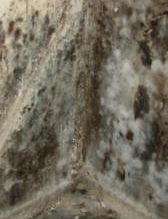 |
| Toxic mold exposure can lead to ill health and respiratory disease. |
Matthew Richert and his wife, Lori George, are suing because they think the toxic mold in their campus apartment caused their daughter's severe respiratory problems.
The couple's daughter Libby, then 1, began to have breathing problems in October 2011, four months after the family arrived.
Santa Cruz doctors couldn't stabilize her, and transferred her to Stanford's pediatric intensive care unit. She spent the next three days in critical condition.
Libby, who was eventually diagnosed with asthma and allergic rhinitis, was hospitalized at Stanford three more times.
At first, the couple was unsure what triggered Libby's attacks, and took their older daughter out of preschool to minimize germ exposure.
The family started noticing mold on their walls in fall of 2011, around the same time Libby first got sick. They tried to manage it, but it returned.
In June 2012, Libby's doctor wrote a letter to UCSC housing requesting the family be transferred if the mold couldn't be removed. Richert and George filed five transfer requests in the following year.
In May, the family conducted an independent mold inspection, which showed five types of toxic mold known to cause severe asthma and allergic rhinitis growing in their apartment.
The university also conducted its own inspection around the same time, which showed damage to the walls. The university transferred the family to a hotel a few days later. The apartment remains unoccupied.
"It's very frustrating, it's very scary and we're not the only ones," George said.
In March 2009, more than 100 residents gathered at Family Student Housing to protest rising rent and substandard living conditions. Many complained that mold was growing in their apartments and allergy attacks kept their children up coughing at night.In April, then-resident Orville Canter collected 142 signatures from residents who said their units were infested with mold, despite cleaning and common-sense prevention methods.
Editor's note: This article has been edited for length.
Source: Santa Cruz Sentinel
Most indoor air contaminants can be removed with a high-quality air purifier that features many pounds of activated carbon and HEPA air filters.
Electrocorp has designed a wide range of industrial-strength air cleaners with carbon + HEPA filter system, and it has provided cleaner air to many schools and universities as well as other educational facilities.
For more information, contact Electrocorp.
No comments:
Post a Comment